How to Get Rid of Pantry Moths
Pantry moths are a common nuisance in many households, invading our kitchens and contaminating food supplies. This blog post provides a comprehensive guide on identifying these pests, understanding their impact, and effectively eliminating them from your home. We’ll examine signs of infestations, debunk myths, and distinguish between pantry moths and other household pests. Additionally, you’ll find practical tips on preventing future infestations and answers to frequently asked questions. Whether you’re tackling an existing problem or taking preventive measures, this article will equip you with the knowledge needed to keep your pantry pest-free.
What Are Pantry Moths?
Pantry moths, also known as Indian meal moths, are small insects that infest stored food products. They thrive in warm environments and are attracted to dried goods such as flour, grains, and cereals. Adult pantry moths are often easy to recognize by their distinctive brownish wings, which feature a copper-colored band across the lower half.
These moths begin their lifecycle as eggs, hatching into larvae that feed on your pantry goods. The larvae stage is where they do most damage, boring into food and spinning silken webs that contaminate your supplies. Understanding their lifecycle is crucial for effectively dealing with an infestation.
Look For Signs Of Infestation
Spotting a pantry moth infestation in its early stages can save you time and preserve your food. Look for small moths flying around your kitchen or in your pantry. Inspect dried goods for webbing or clumped-together contents, as these are indicative of larvae activity. Another sign is finding larvae or pupae in corners or inside food packages.
It’s essential to act quickly once signs are detected. The longer pantry moths are left unchecked, the larger the infestation can become, spreading to more food items and making eradication more challenging. Regularly inspecting stored food can help catch these pests early.
Are Pantry Moths Harmful?
While pantry moths don’t transmit diseases, their presence in food is undesirable. Consuming contaminated food can lead to digestive discomfort, not due to the moths themselves but the bacteria introduced during an infestation. The larvae’s feeding can reduce the quality and nutritional value of your food items.
Moreover, the economic impact of losing food to these pests can be significant, requiring you to discard and repurchase affected products. Maintaining a pantry free from moths helps ensure that your food remains safe, fresh, and nutritious for consumption.
Are Pantry Moths And Clothes Moths The Same?
Pantry moths and clothes moths are often confused, but they infest different areas. Clothes moths target fabrics and can often be found in closets or storage areas, where they feed on wool, silk, and other natural fibers. Meanwhile, pantry moths specifically seek out food supplies.
While both types of moths can be household pests, the methods for dealing with them differ. Understanding their distinctions helps in taking appropriate measures, ensuring you target the right pest with the right solution.
How To Get Rid Of Pantry Moths
To eliminate pantry moths, start by removing all items from your pantry and inspect them thoroughly for signs of infestation. Dispose of any contaminated products in sealed garbage bags. Cleaning shelves and containers with warm, soapy water or a vinegar solution can help eradicate any remaining eggs or larvae.
Once cleaning is complete, use airtight containers for storage to prevent re-infestation. Consider using natural deterrents, such as bay leaves or cedar, to repel moths. Regular cleaning and inspection play a vital role in ensuring these pests do not return.
How To Prevent Pantry Moths
Prevention of pantry moth infestations involves several steps. Inspect groceries before purchasing, looking for damaged packaging or contents. Upon bringing items home, transfer them into airtight containers to protect them from potential infestations.
Regular cleaning of pantry spaces and proper rotation of food supplies help maintain pantry hygiene. Utilize natural repellents and regularly monitor your pantry to catch any signs of infestation before they become severe.
Frequently Asked Questions
How long do pantry moths live?
Pantry moths typically have a lifespan of 1-2 weeks as adults, but their larvae stage can last several weeks.
Can pantry moths infest other parts of the house?
While they primarily infest pantry spaces, pantry moths can occasionally spread to other areas, especially where food is present.
What is the best way to store food to prevent moth infestations?
Using airtight containers and proper storage methods can significantly reduce the risk of pantry moth infestations.
Key Takeaways
- Identifying pantry moths early helps prevent significant infestations.
- Removing infested items and cleaning thoroughly are crucial steps in eradication.
- Proper storage and prevention tactics reduce future infestation risks.
Final Thoughts
| Aspect | Description |
|---|---|
| Identifying Pantry Moths | Look for small brown moths, webbing, or larvae in dried foods. |
| Risks | Not harmful but contaminate food, leading to waste and potential digestive discomfort. |
| Pest Differences | Pantry moths target food, while clothes moths target fabrics. |
| Eradication | Remove infested items, clean thoroughly, use airtight containers. |
| Prevention | Inspect groceries, use airtight containers, clean regularly, use natural repellents. |


